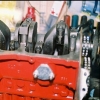1999 Mini Mpi Injection Issues
Best Answer Jaforward , 30 April 2024 - 07:57 AM
Sorry it’s taken so one to reply to this one, I can confirm it’s fixed. During my extensive checking I came across many small issues that probably weren’t helping matters. To recap, car had persistent misfire on Cylinders 1&2.
Compressions on cylinders 1&2 were down, head removed and exhaust valves replaced.
Pressures now even across all cylinders @ 185psi.
Engine running very rich. Injector for cylinder 1&2 was injecting far more fuel than 3&4 although the duty times from live data were the same.
ECU sent away for testing and returned with a clean bill of health.
Check for vacuum or exhaust leaks , manifolds removed again and checked for straightness , all ok.
O2 sensor removed to check sealing washer, very stubborn to remove and threads spalled when it did come out.
O2 sensor replaced with a aftermarket version.
O2 reading now very odd stuck at one end of the scale (can’t remember which), following other posts I realised that the internal wiring of the replacement was incorrect (no earth ?), genuine Bosch sensor fitted, readings now changing between lean and rich but only for a short time before sticking at rich.
While looking for vacuum leaks I found that the O ring for the idle control stepper motor was missing.
Plugs and Coil pack replaced to rule out any internal damage.
Signal from Crank sensor checked on oscilloscope and didn’t look brilliant, some noise present. Removed sensor and found wires inside the sealed end of the sensor badly corroded. Replaced sensor, signals look cleaner but fault remained.
Check wiring to ECU, some additional earths had been added, one was connecting the earth screens of the crank, cam & O2 sensor directly to battery earth. On measuring the terminal on the ECU there was 1k resistance between that and earth, making me think that like the signal earth returns the screen should float slightly above battery earth. I removed that extra link but no improvement.
Occasionally and very randomly the car would run on 4 cylinders but still running rich, any attempt to load the engine by driving or revving hard would usually bring the persistent misfire back.
Injectors taken for testing / cleaning at ASNU Uk (local to me) I watched the procedure and was impressed by the knowledge and attention to detail, they were ok but cleaned anyway to remove any varnished fuel.
I had tried to measure the injector currents with a digital clamp meter but found that the frequency was too quick for the meter.
I bought a pico clamp meter and measure the currents at the ECU on both of the drivers for each injector.
Injector 3&4 had typical traces for a peek and hold ? Injector.
Injector 1&2, one of the drivers looked good the others duty cycle was all wrong, very short current pulses and not constant.
As the ECU had previously been apart and repaired (not by me) I removed the lid with it connected and running, as soon as the lid was off the engine misfired very badly, checking the driver voltages at the output stages with the scope all looked good until I reached one of the drivers for 1&2 with the probe connected the engine would run very badly.
With the ECU on the bench and some reverse engineering circuit tracing, a resistor for the gate of one of the FET’s was open circuit (making an aerial that was very susceptible to interference with lid off ?) also the internal resistance of the FET driver IC outputs for each channel varied from 20M ohms on some (I believe correctly) to only 1k ohm on others. I can only assume that the misfiring from the bad valves had caused the ignition coil to spike and toasted part of the ECU ? (assuming the chip drives injectors and ignition coil outputs).
I bought a 2nd hand Mems 2J ECU from a MGF and swapped out the damaged components. Although the FET for the injector with poor current readings tested ok I replaced it anyway.
The engine now runs and drives on all cylinders with the O2 sensor readings correct.
0.7% CO at the tailpipe seems slightly high but the engine is running a 3 branch exhaust manifold with the O2 sensor only seeing the centre cylinders.
Very pleased to see the back of this one.

#16

Posted 19 October 2023 - 10:39 AM
#17

Posted 19 October 2023 - 11:57 AM
Check wiring at the ecu plug, that can corrode pretty badly causing an increase in amperage (higher resistance).
Increased resistance will cause lower amperage given a fixed base voltage, but yes, good suggestion to check.
#18

Posted 19 October 2023 - 02:39 PM
Increased resistance will cause lower amperage given a fixed base voltage, but yes, good suggestion to check.
Check wiring at the ecu plug, that can corrode pretty badly causing an increase in amperage (higher resistance).
Good point, well made! 😆
#19

Posted 19 October 2023 - 04:17 PM
During my initial check when I realised it wasn’t anything simple I checked all the wiring to every engine sensor (under load rather than just resistance)) at the ECU plugs they all looked good. The extra fuel happens as soon the engine is cranking, I don’t think the O2 sensor will have any influence on the fuelling as it hasn’t heated up yet. If I leave it running till hot the O2 sensor registers the rich mixture and doesn’t switch. If I disconnect the injector for 1&2 after a few seconds it switches correctly giving a reading I would expect for a working sensor at idle. I will post the waveforms from the injectors as soon as I can get back to it.
#20

Posted 19 October 2023 - 05:04 PM
#21

Posted 30 April 2024 - 07:57 AM Best Answer
Sorry it’s taken so one to reply to this one, I can confirm it’s fixed. During my extensive checking I came across many small issues that probably weren’t helping matters. To recap, car had persistent misfire on Cylinders 1&2.
Compressions on cylinders 1&2 were down, head removed and exhaust valves replaced.
Pressures now even across all cylinders @ 185psi.
Engine running very rich. Injector for cylinder 1&2 was injecting far more fuel than 3&4 although the duty times from live data were the same.
ECU sent away for testing and returned with a clean bill of health.
Check for vacuum or exhaust leaks , manifolds removed again and checked for straightness , all ok.
O2 sensor removed to check sealing washer, very stubborn to remove and threads spalled when it did come out.
O2 sensor replaced with a aftermarket version.
O2 reading now very odd stuck at one end of the scale (can’t remember which), following other posts I realised that the internal wiring of the replacement was incorrect (no earth ?), genuine Bosch sensor fitted, readings now changing between lean and rich but only for a short time before sticking at rich.
While looking for vacuum leaks I found that the O ring for the idle control stepper motor was missing.
Plugs and Coil pack replaced to rule out any internal damage.
Signal from Crank sensor checked on oscilloscope and didn’t look brilliant, some noise present. Removed sensor and found wires inside the sealed end of the sensor badly corroded. Replaced sensor, signals look cleaner but fault remained.
Check wiring to ECU, some additional earths had been added, one was connecting the earth screens of the crank, cam & O2 sensor directly to battery earth. On measuring the terminal on the ECU there was 1k resistance between that and earth, making me think that like the signal earth returns the screen should float slightly above battery earth. I removed that extra link but no improvement.
Occasionally and very randomly the car would run on 4 cylinders but still running rich, any attempt to load the engine by driving or revving hard would usually bring the persistent misfire back.
Injectors taken for testing / cleaning at ASNU Uk (local to me) I watched the procedure and was impressed by the knowledge and attention to detail, they were ok but cleaned anyway to remove any varnished fuel.
I had tried to measure the injector currents with a digital clamp meter but found that the frequency was too quick for the meter.
I bought a pico clamp meter and measure the currents at the ECU on both of the drivers for each injector.
Injector 3&4 had typical traces for a peek and hold ? Injector.
Injector 1&2, one of the drivers looked good the others duty cycle was all wrong, very short current pulses and not constant.
As the ECU had previously been apart and repaired (not by me) I removed the lid with it connected and running, as soon as the lid was off the engine misfired very badly, checking the driver voltages at the output stages with the scope all looked good until I reached one of the drivers for 1&2 with the probe connected the engine would run very badly.
With the ECU on the bench and some reverse engineering circuit tracing, a resistor for the gate of one of the FET’s was open circuit (making an aerial that was very susceptible to interference with lid off ?) also the internal resistance of the FET driver IC outputs for each channel varied from 20M ohms on some (I believe correctly) to only 1k ohm on others. I can only assume that the misfiring from the bad valves had caused the ignition coil to spike and toasted part of the ECU ? (assuming the chip drives injectors and ignition coil outputs).
I bought a 2nd hand Mems 2J ECU from a MGF and swapped out the damaged components. Although the FET for the injector with poor current readings tested ok I replaced it anyway.
The engine now runs and drives on all cylinders with the O2 sensor readings correct.
0.7% CO at the tailpipe seems slightly high but the engine is running a 3 branch exhaust manifold with the O2 sensor only seeing the centre cylinders.
Very pleased to see the back of this one.
1 user(s) are reading this topic
0 members, 1 guests, 0 anonymous users















